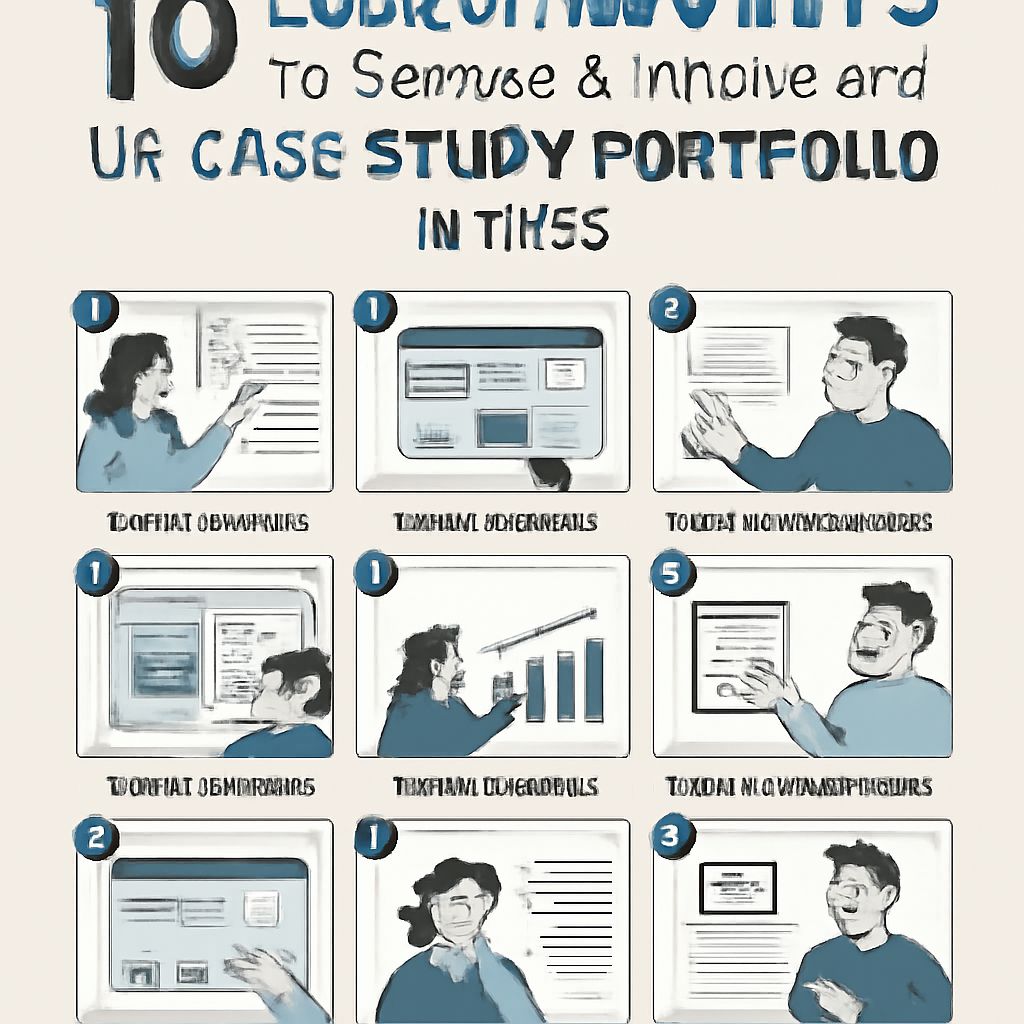10 Steps to a Winning UX Case Study Portfolio
Discover the 10 essential steps to create a compelling UX case study portfolio that stands out in 2025.

Table of Contents
10 Essential Steps to Create a Winning UX Case Study Portfolio in 2025
In today’s competitive landscape, a well-crafted UX case study portfolio is essential for any aspiring or established user experience designer. As we move forward into 2025, the expectations and standards for these portfolios will continue to evolve. This article outlines ten essential steps to create a compelling and effective UX case study portfolio that showcases your skills and makes a lasting impression on potential employers.
1. Understand Your Audience
Before you start creating your portfolio, take the time to understand who your audience is. Are you targeting potential employers, freelance clients, or collaborators? Knowing your audience will help you tailor your case studies accordingly.
2. Select the Right Projects
Your portfolio should feature a diverse range of projects that showcase your skills in various areas of UX design. Consider including:
- Research Projects: Highlight any user research, usability testing, or surveys you’ve conducted.
- Design Projects: Include wireframes, prototypes, and final products that demonstrate your design skills.
- Collaborative Projects: Showcase your ability to work within a team, highlighting your contributions.
- Personal Projects: If applicable, showcase passion projects that highlight your creativity and problem-solving abilities.
3. Structure Your Case Studies
A well-structured case study is crucial for clarity. Here’s a recommended structure:
| Section | Description |
|---|---|
| Introduction | Provide a brief overview of the project and your role. |
| Problem Statement | Clearly define the problem you aimed to address. |
| Process | Outline your approach, including research, ideation, design, and testing. |
| Outcomes | Share results, metrics, and feedback that demonstrate the success of your solution. |
| Reflection | Discuss what you learned and how you could improve in future projects. |
4. Focus on the Problem-Solving Process
Employers look for designers who can think critically and solve problems. Your case studies should not only present the final product but also illustrate the design thinking process you engaged in to arrive at your solutions. Be sure to discuss research methods, user personas, and scenarios to show how you arrived at your design decisions.
5. Use Visuals Effectively
Visual storytelling is essential in UX portfolios. Incorporate a variety of visuals to engage viewers:
- Wireframes and Prototypes: Display your design iterations and thought processes.
- User Journey Maps: Help illustrate the user’s experience with your design.
- Screenshots: Use high-quality images of your final product to give life to your case study.
6. Write Clearly and Concisely
Your writing should be straightforward and professional. Avoid jargon and overly complex language. Use bullet points and headings to break up text, making it easier for readers to digest. Aim for clarity over flair, ensuring that the essential points stand out.
7. Showcase User Feedback and Metrics
To demonstrate the effectiveness of your designs, include user feedback and measurable results. This could be:
- Increased user engagement rates
- Improved conversion rates
- User satisfaction scores
Quantifiable data provides credibility to your claims and shows prospective employers that you deliver measurable results.
8. Keep It Updated
Your UX case study portfolio should be a living document. As you complete new projects and gain new skills, update your portfolio to reflect your most recent work. Regularly review and refine your case studies to ensure they remain relevant and showcase your current capabilities.
9. Establish a Professional Online Presence
In addition to your portfolio, establish a strong online presence. Consider setting up:
- A Personal Website: Your portfolio should be hosted on a professional website that reflects your personal brand.
- Social Media Profiles: Use platforms like LinkedIn and Twitter to connect with other design professionals and share insights.
- Design Community Contributions: Participate in online design communities, sharing your knowledge and experiences.
10. Seek Feedback and Iterate
Finally, actively seek feedback from peers, mentors, or professionals in the field. Use their insights to refine your portfolio. Remember, the goal is to present your best work in the most effective manner possible. Iteration is key to creating a winning case study portfolio.
Conclusion
Creating a winning UX case study portfolio in 2025 requires careful planning, dedication, and a strong understanding of current trends in user experience design. By following these ten essential steps, you can build a compelling portfolio that not only highlights your skills but also tells a story of your journey as a designer. Whether you’re entering the job market or looking to advance your career, a well-crafted portfolio can be your ticket to success in the ever-evolving world of UX design.
FAQ
What is a UX case study portfolio?
A UX case study portfolio is a collection of projects that showcase a designer’s process, skills, and problem-solving abilities in user experience design.
Why is a UX case study portfolio important?
A well-crafted UX case study portfolio demonstrates your design thinking, project management, and user-centered design skills, making it easier to attract potential employers or clients.
What are the essential elements of a UX case study?
Key elements include a project overview, research findings, design process, user testing insights, final designs, and reflections on what was learned.
How can I make my UX case study stand out?
Use storytelling techniques, include visuals, focus on your unique contributions, and highlight the impact of your design solutions.
What tools can I use to create a UX case study portfolio?
Popular tools include Adobe XD, Figma, Sketch, and online platforms like Behance or Dribbble for showcasing your work.
How often should I update my UX case study portfolio?
You should update your portfolio regularly, ideally whenever you complete new projects or gain new skills to ensure it reflects your current abilities.

